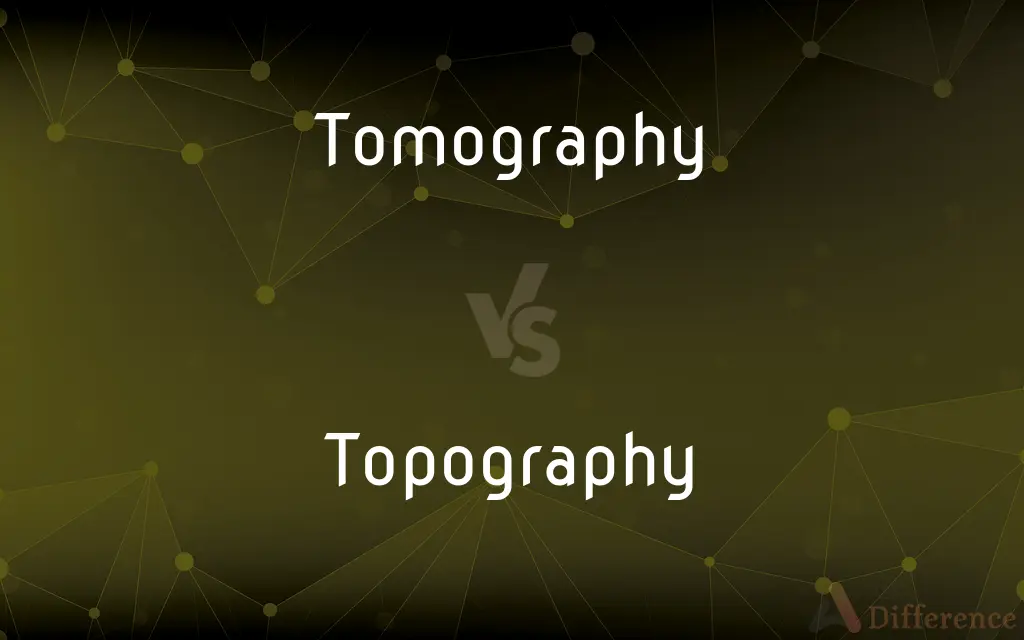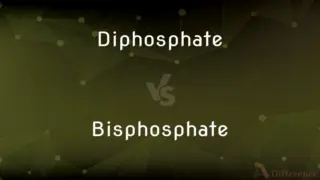Tomography vs. Topography — What's the Difference?
By Urooj Arif & Maham Liaqat — Updated on March 27, 2024
Tomography is a medical imaging technique creating detailed cross-sections of the body, whereas topography refers to the study and depiction of Earth's surface features, highlighting their differences in application and focus.

Difference Between Tomography and Topography
Table of Contents
ADVERTISEMENT
Key Differences
Tomography, derived from the Greek words "tomos" (slice) or "graphia" (writing), is a technique used in medical imaging and other fields to produce detailed cross-sectional images of the body or objects. In contrast, topography comes from "topos" (place) and "graphia" (writing), focusing on mapping and studying the Earth's surface features, including mountains, valleys, and bodies of water.
While tomography is primarily associated with healthcare and scientific research, allowing for non-invasive examinations inside the human body or materials, topography plays a crucial role in geographical sciences, engineering, and navigation. Tomographic imaging techniques, such as CT scans and MRIs, utilize advanced technology to visualize internal structures, aiding in medical diagnosis and treatment planning. Conversely, topographical maps and models provide detailed representations of geographical areas, supporting land use planning and outdoor activities like hiking and military operations.
The differences in equipment and methodology between tomography and topography are significant. Tomography employs sophisticated machines that emit waves (X-rays, sound waves, etc.) to capture slice-by-slice images of an object's internal structure. Topography, however, uses surveying tools, satellite imagery, and GPS technology to measure and depict the Earth's surface contours and features accurately.
Both fields require specialized knowledge and skills but in different domains. Tomography demands expertise in medical physics, radiology, and engineering to interpret the images accurately and apply them in medical diagnoses or material analysis. Topography requires skills in geodesy, cartography, and geographic information systems (GIS) to create maps and models that are both accurate and informative.
Despite their differences, tomography and topography share the fundamental concept of detailed layer analysis, whether it's of the human body or the Earth's surface. However, their applications, techniques, and the nature of the studies place them in distinct categories of scientific inquiry and practical use.
ADVERTISEMENT
Comparison Chart
Definition
Technique for producing cross-sectional images of the body or objects.
Study and depiction of Earth's surface features.
Primary Use
Medical imaging and material analysis.
Mapping and geographical planning.
Technology
CT scans, MRIs, ultrasound.
Satellite imagery, GPS, surveying tools.
Fields Involved
Medicine, physics, engineering.
Geography, cartography, environmental science.
Focus
Internal structure analysis.
Surface layout and features.
Methodology
Slice-by-slice imaging using waves.
Measurement and modeling of terrain.
Skills Required
Radiology, medical physics.
GIS, surveying, cartography.
Applications
Diagnosis, research, industry.
Urban planning, navigation, environmental study.
Compare with Definitions
Tomography
Imaging technique for body's cross-sections.
CT tomography revealed the tumor's exact location.
Topography
Mapping Earth's surface features.
The topography of the area includes mountains and rivers.
Tomography
Utilizes X-rays, sound waves.
Ultrasound tomography is used for prenatal screenings.
Topography
Uses satellite imagery, GPS.
Satellite topography provides detailed land elevation data.
Tomography
Aids in medical diagnosis.
MRI tomography is crucial for diagnosing brain disorders.
Topography
Fundamental in geography and cartography.
Studying topography helps understand land use patterns.
Tomography
Involves layer-by-layer analysis.
Tomography can examine the layers of a painting for authenticity.
Topography
Depicts physical layout of territories.
Topographical maps are used by hikers to navigate trails.
Tomography
Essential in research and healthcare.
Tomography advancements have improved cancer detection.
Topography
Supports urban and environmental planning.
Topography is crucial for flood defense planning.
Tomography
Tomography is imaging by sections or sectioning that uses any kind of penetrating wave. The method is used in radiology, archaeology, biology, atmospheric science, geophysics, oceanography, plasma physics, materials science, astrophysics, quantum information, and other areas of science.
Topography
Topography is the study of the forms and features of land surfaces. The topography of an area could refer to the surface forms and features themselves, or a description (especially their depiction in maps).
Tomography
Any of several techniques for creating three-dimensional images of the internal structure of a solid object by analyzing the propagation of waves of energy, such as x-rays or seismic waves, through the object.
Topography
The arrangement of the natural and artificial physical features of an area
The topography of the island
Tomography
Imaging by sections or sectioning.
Tomographic imaging
Topography
The distribution of parts or features on the surface of or within an organ or organism.
Tomography
(medicine) obtaining pictures of the interior of the body
Topography
Detailed, precise description of a place or region.
Topography
Graphic representation of the surface features of a place or region on a map, indicating their relative positions and elevations.
Topography
A description or an analysis of a structured entity, showing the relations among its components
In the topography of the economy, several depressed areas are revealed.
Topography
The surface features of a place or region.
Topography
The surface features of an object
The topography of a crystal.
Topography
The surveying of the features of a place or region.
Topography
The study or description of an anatomical region or part.
Topography
A precise description of a place.
Topography
A detailed graphic representation of the surface features of a place or object.
Topography
The features themselves; terrain.
Topography
The surveying of the features.
Topography
(by extension) A figurative landscape; a structure of interrelated ideas, etc.
Topography
The description of a particular place, town, manor, parish, or tract of land; especially, the exact and scientific delineation and description in minute detail of any place or region.
Topography
The configuration of a surface and the relations among its man-made and natural features
Topography
Precise detailed study of the surface features of a region
Common Curiosities
Can tomography be used outside of medicine?
Yes, tomography is also used in fields like archaeology, materials science, and geology for analyzing the internal structure of objects or the Earth.
How do tomography and topography differ in technology?
Tomography utilizes technologies like CT scans and MRIs to image body interiors, whereas topography uses satellite imagery and GPS for Earth's surface mapping.
What is tomography used for?
Tomography is used in medical imaging to create detailed images of the inside of the body, aiding in diagnosis and treatment planning.
Why is topography important in urban planning?
Topography is essential in urban planning for understanding land elevation, slopes, and water flow, which influences building locations, infrastructure development, and environmental management.
What role does topography play in environmental science?
Topography is key in environmental science for assessing land use, studying ecosystems, and planning conservation efforts based on the physical characteristics of the land.
What does topography represent?
Topography represents the physical features of a geographical area, including its relief and the position of natural and man-made features.
What skills are needed for topography?
Skills in GIS, surveying, cartography, and an understanding of geographic information systems are crucial for topography.
How has technology impacted tomography?
Advances in technology have significantly improved the resolution, speed, and safety of tomographic imaging, enhancing its diagnostic capabilities.
Can topographical maps help in disaster management?
Yes, topographical maps are vital in disaster management for identifying flood zones, landslide-prone areas, and planning evacuation routes.
What advancements have been made in tomography?
Recent advancements in tomography include higher resolution imaging, faster scan times, and the development of less invasive techniques, improving patient care and research outcomes.
Share Your Discovery

Previous Comparison
Diphosphate vs. Bisphosphate
Next Comparison
Devolve vs. EvolveAuthor Spotlight
Written by
Urooj ArifUrooj is a skilled content writer at Ask Difference, known for her exceptional ability to simplify complex topics into engaging and informative content. With a passion for research and a flair for clear, concise writing, she consistently delivers articles that resonate with our diverse audience.
Co-written by
Maham Liaqat













































